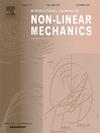变阶分数阶粘弹性振荡器在冲击载荷下的特性分析
IF 2.8
3区 工程技术
Q2 MECHANICS
International Journal of Non-Linear Mechanics
Pub Date : 2025-07-09
DOI:10.1016/j.ijnonlinmec.2025.105206
引用次数: 0
摘要
粘弹性振子作为连接材料性能和系统动力性能的关键桥梁,在工程实践中具有重要意义。通过将变阶分数阶黏弹性振子(VOF)本构模型嵌入到粘弹性振子中,建立了冲击载荷作用下的变阶分数阶粘弹性振子(VOFVO)动力学模型。采用拉普拉斯变换法、块脉冲函数和泰勒多项式的混合方法求解VOFVO动态模型的时域和频域系统响应。进行了劈裂霍普金森压杆(SHPB)冲击试验。通过与常分数阶Kelvin-Voigt (CFKV)模型和Zhu-Wang-Tang非线性热粘弹性本构(ZWT)模型的对比分析,验证了VOF模型的准确性。结果表明:高弹性阶段Ⅱ的VOFVO具有最佳的阻尼特性,振动幅值最小,振动周期最短,振动衰减最快;在频域上,三个阶段VOFVO响应的共振峰出现在频率比为1附近。固有频率wn、阻尼比ξ和几何因子κ与VOFVO响应呈负相关。随着系统参数的增大,第一幅值从0.017减小到0.0005。与阻尼比ξ相比,固有频率wn对系统响应的影响更为显著。几何因子κ需要综合考虑较小的振动幅值和合理的结构配置来确定。本文章由计算机程序翻译,如有差异,请以英文原文为准。
Analysis of the characteristics of variable-order fractional viscoelastic oscillator under impact loading
As a critical bridge connecting material properties and dynamic behaviors of system, the viscoelastic oscillator is important in engineering practice. By embedding the variable-order fractional (VOF) constitutive model into viscoelastic oscillator, a variable-order fractional viscoelastic oscillator (VOFVO) dynamic model under impact loading is established. The methods of Laplace transform method, hybrid of block-pulse function and Taylor polynomial are used to solve the system responses of VOFVO dynamic model in time and frequency domains. The Split Hopkinson Pressure Bar (SHPB) impact experiment is conduced. Through a comparative analysis with the Constant fractional-order Kelvin-Voigt (CFKV) model and the Zhu-Wang-Tang nonlinear thermo-viscoelastic constitutive (ZWT) model, the accuracy of the VOF model is validated. The results show that the VOFVO in the high elastic stage Ⅱ has the best damping characteristics with the smallest vibration amplitude, the shortest vibration period, and the fastest vibration attenuation. In the frequency domain, the resonance peaks of VOFVO responses in the three stages appear near a frequency ratio of one. The natural frequency , damping ratio and geometric factor are negatively correlated with the VOFVO responses. The first amplitude decreases from 0.017 to 0.0005 as the system parameters increased. Compared to the damping ratio , the natural frequency has a more significant impact on the system responses. The geometric factor needs to be determined by comprehensively considering the smaller vibration amplitudes and rational structural configuration.
求助全文
通过发布文献求助,成功后即可免费获取论文全文。
去求助
来源期刊
CiteScore
5.50
自引率
9.40%
发文量
192
审稿时长
67 days
期刊介绍:
The International Journal of Non-Linear Mechanics provides a specific medium for dissemination of high-quality research results in the various areas of theoretical, applied, and experimental mechanics of solids, fluids, structures, and systems where the phenomena are inherently non-linear.
The journal brings together original results in non-linear problems in elasticity, plasticity, dynamics, vibrations, wave-propagation, rheology, fluid-structure interaction systems, stability, biomechanics, micro- and nano-structures, materials, metamaterials, and in other diverse areas.
Papers may be analytical, computational or experimental in nature. Treatments of non-linear differential equations wherein solutions and properties of solutions are emphasized but physical aspects are not adequately relevant, will not be considered for possible publication. Both deterministic and stochastic approaches are fostered. Contributions pertaining to both established and emerging fields are encouraged.

 求助内容:
求助内容: 应助结果提醒方式:
应助结果提醒方式:


